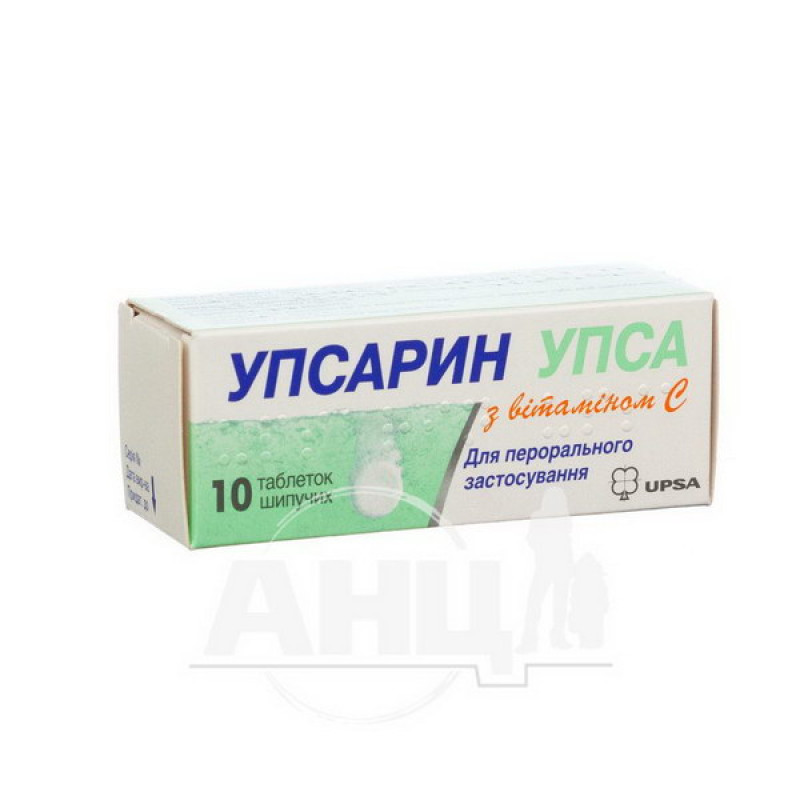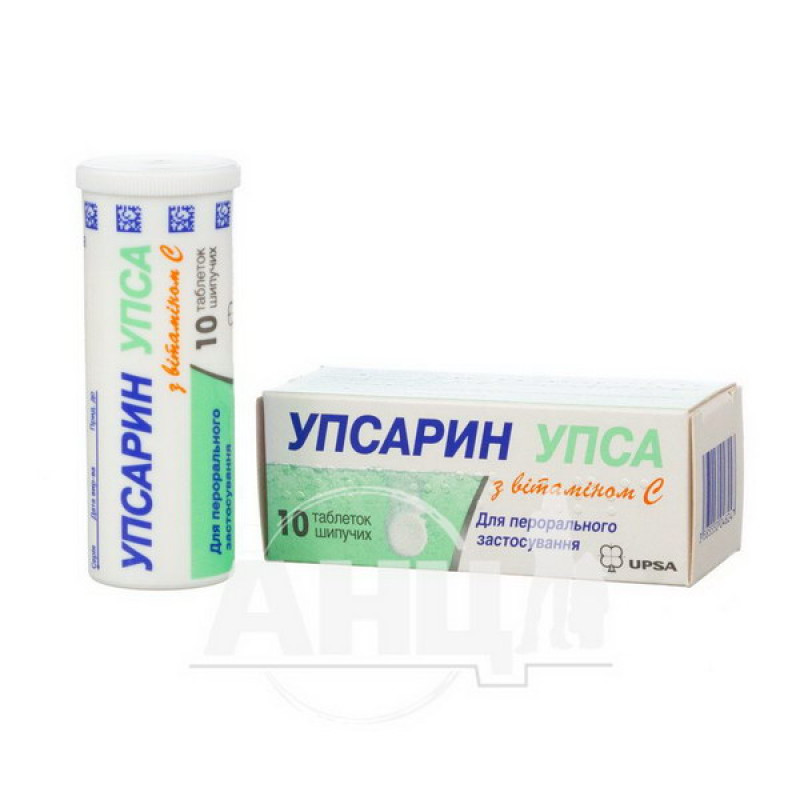Upsarin Upsa with vitamin C effervescent tablets tube No. 10

Effervescent tablets "Upsarin Upsa with vitamin C" are used for the symptomatic treatment of mild to moderate pain and/or fever.
Composition
One effervescent tablet contains (active ingredients):
acetylsalicylic acid - 330 mg; ascorbic acid (vitamin C) - 200 mg.Excipients: sodium bicarbonate, anhydrous citric acid, povidone, sodium benzoate (E 211).
Contraindication
hypersensitivity to acetylsalicylic acid, other salicylates, ascorbic acid or to any component of the drug; bronchial asthma caused by the use of salicylates or other NSAIDs in history; gastrointestinal ulcers; hemorrhagic diathesis; risk of bleeding; severe kidney disease, severe renal failure; urolithiasis; severe liver failure; severe heart failure; tendency to thrombosis, thrombophlebitis; diabetes mellitus; combination with methotrexate at a dose of 20 mg/week or more; III trimester of pregnancy at a dose of more than 100 mg per day; combination of oral anticoagulants with anti-inflammatory doses (≥ 1 g per dose and / or ≥ 3 g per day) or analgesic or antipyretic doses (≥ 500 mg per dose and / or < 3 g per day) of acetylsalicylic acid.Method of application
For oral use.
Completely dissolve the tablet in a large glass of water and drink immediately.
The drug is used for adults and children over 15 years of age.
Adults and children weighing more than 50 kg (approximately 15 years and older): the maximum recommended daily dose is 3 g of acetylsalicylic acid, i.e. 9 effervescent tablets per day.
A single dose is two effervescent tablets. If necessary, the dose can be repeated after 4 hours.
Frequency of receptions
Regular treatments help avoid fluctuations in pain and fever:
from the age of 15, a regular interval between doses should be observed both day and night, preferably 6 hours, but not less than 4 hours; in adults, the interval between doses should be at least 4 hours.The duration of treatment is determined by the doctor individually. It should be remembered that acetylsalicylic acid should be taken for no more than 3 days to treat fever and no more than 5 days to treat pain.
Application features
Pregnant women
The drug can be used during pregnancy only if other drugs are ineffective. Salicylates can be used during pregnancy only after assessing the risk / benefit ratio.
Since acetylsalicylic acid passes into breast milk, the use of the drug during breastfeeding is not recommended.
Children
The drug can be used in children over 15 years of age. Drugs containing acetylsalicylic acid should not be used in children with acute respiratory viral infections (ARI), which are accompanied or not accompanied by an increase in body temperature. With some viral diseases, especially influenza A, influenza B and chickenpox, there is a risk of developing Reye's syndrome, which is a very rare but life-threatening disease that requires urgent medical intervention. The risk may be increased if acetylsalicylic acid is used as a concomitant drug, but a causal relationship in this case has not been proven. If these conditions are accompanied by prolonged vomiting, this may be a sign of Reye's syndrome.
Drivers
No effect on the ability to drive or use other mechanisms was noted.
Overdose
Salicylate overdose is possible due to chronic intoxication resulting from long-term therapy (administration of more than 100 mg/kg/day for more than 2 days may cause toxic effects), as well as due to acute intoxication that is life-threatening (overdose), the causes of which may be, for example, accidental use by children or an unforeseen overdose.
Chronic salicylate poisoning can be insidious because its signs are nonspecific. Moderate chronic salicylate intoxication, or salicylism, usually occurs only after ingestion of large doses.
Symptoms
Overdose of ascorbic acid can lead to oxidative hemolysis in patients with glucose-6-phosphate dehydrogenase deficiency, DIC, and elevated serum and urine oxalate levels. Elevated oxalate levels have been shown to lead to calcium deposition in patients on dialysis. Other symptoms include balance disorders, dizziness, tinnitus, deafness, headache, and confusion. These symptoms can be controlled by reducing the dose. Tinnitus may occur at plasma salicylate concentrations of more than 150-300 μg/mL. Serious adverse reactions occur at plasma salicylate concentrations of more than 300 μg/mL.
Acute intoxication is indicated by a pronounced change in the acid-base balance, which may vary depending on age and severity of intoxication. The most common indicator for children is metabolic acidosis. The severity of the condition cannot be assessed solely on the basis of the concentration of salicylates in the blood plasma. The absorption of acetylsalicylic acid may be slowed down due to delayed gastric release, the formation of concrements in the stomach or when taking the drug in the form of tablets coated with an enteric coating.
Treatment
Treatment of intoxication caused by an overdose of acetylsalicylic acid is determined by the severity, clinical symptoms and is provided by standard methods used in poisoning. All measures taken should be aimed at accelerating the removal of the drug and restoring electrolyte and acid-base balance. Use activated charcoal, forced alkaline diuresis. Depending on the state of acid-base balance and electrolyte balance, carry out infusion of electrolyte solutions. In case of serious poisoning, hemodialysis is indicated.
Side effects
Gastrointestinal disorders: dyspepsia, epigastric and abdominal pain, heartburn, diarrhea, nausea, vomiting, stomach cramps.
Blood system: increased risk of bleeding; intraoperative hemorrhages, hematomas, bleeding from the genitourinary system, nosebleeds, bleeding from the gums, purpura.
Allergic reactions: rash, urticaria, angioedema, itching, rhinitis, nasal congestion, eczema.
In patients with bronchial asthma, there may be an increased frequency of bronchospasm; allergic reactions of minor to moderate severity, potentially affecting the skin, respiratory system, gastrointestinal tract and cardiovascular system.
Nervous system: headache, vertigo, increased fatigue, a feeling of hearing loss, dizziness and ringing in the ears, which may indicate an overdose.
With prolonged use in high doses, the following are possible: damage to the glomerular apparatus of the kidneys, the formation of urate and / or oxalate stones in the kidneys and urinary tract, renal failure; damage to the insular apparatus of the pancreas (hyperglycemia, glucosuria) and impaired glycogen synthesis until the onset of diabetes mellitus, myocardial dystrophy; thrombocytosis, hyperprothrombinemia, erythrocytopenia, neutrophilic leukocytosis, hemolytic anemia; decreased capillary permeability (possible deterioration of tissue trophism, increased blood pressure); oral dysbacteriosis; impaired zinc and copper metabolism. In patients with severe glucose-6-phosphate dehydrogenase deficiency, hemolysis and the development of hemolytic anemia have been reported.
Storage conditions
Store at a temperature not exceeding 25 °C, in a tightly closed tube to prevent moisture from entering. Keep out of the reach of children.
Shelf life - 2 years.
There are no reviews for this product.
There are no reviews for this product, be the first to leave your review.
No questions about this product, be the first and ask your question.



